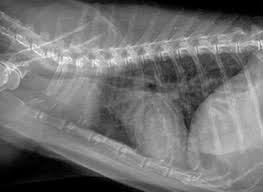Valley Fever in Dogs

I have followed with some interest the newspaper stories on the invasive fungus, coccidiodomycosis, that causes Valley Fever in people here, up and down the Central Valley. Coming from Arizona years ago, another dry, warm climate where the Fungal infection is extremely common, I learned a lot about Valley Fever, if for no other reason than you won’t pass the Arizona State Boards to practice there if you don’t. It’s just that common in Arizona, the fungal spores picked up in the dry winds blowing off the mountains and desert, settling in the lungs and bodies of two especially susceptible species : Man and his best friend, the dog.
 This is not your everyday little athlete’s foot fungus or swimmers ear kind of yeast that creates mildly aggravating rashes and inspires odd TV commercials. While most fungi like a moist environment, they have trouble getting past the body’s great defense : skin. Coccidiodomycosis (we’re going to shorten that to “VF” for Valley Fever pretty quick here) is a “systemic” fungi, meaning the fungal spores invade deep inside the bodies’ systems and organs. I know of 3 different systemic fungi common to the United States, each found primarily in its own region of the country. For us in the Central Valley desert and arid parts of the West, we have to deal with Valley Fever.
This is not your everyday little athlete’s foot fungus or swimmers ear kind of yeast that creates mildly aggravating rashes and inspires odd TV commercials. While most fungi like a moist environment, they have trouble getting past the body’s great defense : skin. Coccidiodomycosis (we’re going to shorten that to “VF” for Valley Fever pretty quick here) is a “systemic” fungi, meaning the fungal spores invade deep inside the bodies’ systems and organs. I know of 3 different systemic fungi common to the United States, each found primarily in its own region of the country. For us in the Central Valley desert and arid parts of the West, we have to deal with Valley Fever.
It was July of 2011 when Mr. Cardwell brought his dog in. Named “Tick”, she was a hound of mixed pedigree (a bit of a mystery, but every girl needs that) going into her 11th year of age. “Tick” had been coughing for a couple days, just a little tickle in her throat but rather persistent. The common stuff we were looking for ran the gamut from Kennel Cough to Heartworm disease to Congestive Heart Failure to Cancer and then some. Every veterinarian’s mind has a ticker tape running through a list of disease possibilities that rivals any Wall Street machine.
We noted she had a high fever. Her weight was good, even plump. We took a set of chest x-rays, and there on the images that captured the outlines of her heart and lungs we could see a fuzzy white shadow lurking low in the right lung. Hmmm. Unfortunately, indistinct shadows are not enough to make a diagnosis (choices, always other possibilities!) and Tick didn’t seem so very sick to Mr. Cardwell. Reasonably enough he asked to treat her for something like Kennel Cough ( a story on that disease complex later, please), so we complied with a course of antibiotics and cough suppressants.
 Which was all well and fine, but no one consulted Tick, and she wasn’t having any of this medicine stuff. No way, no how. After a couple of trips back to our hospital to discuss new ways to get a pill into her, we weren’t sure if her failure to improve was because she wasn’t getting her meds or if it was time to go further in our diagnostic tests. Ten days after we’d first examined her, Tick’s fever was down, but so was her weight. She’d lost 4 pounds (she started at 28) and her lungs sounded dry and crackly. The coughing was persistent, though still more of a wheeze. Mr. Cardwell gave the ok for a battery of general blood and urine tests, which revealed that she did not have heartworm and that most of her organs were functioning well but she had a terrible infection driving her white cell count up over 36,000 (normal’s probably around 8,000). I liken the white cells of the body to Soldiers marching off to battle disease and infection : 36,000 soldiers is a huge army. What WAS that white stuff in her lungs? We sent out a blood test checking for Valley Fever. Tick’s tests were positive on 2 out of 3 run for coccidiodomycosis. Bingo! Definitive diagnosis!
Which was all well and fine, but no one consulted Tick, and she wasn’t having any of this medicine stuff. No way, no how. After a couple of trips back to our hospital to discuss new ways to get a pill into her, we weren’t sure if her failure to improve was because she wasn’t getting her meds or if it was time to go further in our diagnostic tests. Ten days after we’d first examined her, Tick’s fever was down, but so was her weight. She’d lost 4 pounds (she started at 28) and her lungs sounded dry and crackly. The coughing was persistent, though still more of a wheeze. Mr. Cardwell gave the ok for a battery of general blood and urine tests, which revealed that she did not have heartworm and that most of her organs were functioning well but she had a terrible infection driving her white cell count up over 36,000 (normal’s probably around 8,000). I liken the white cells of the body to Soldiers marching off to battle disease and infection : 36,000 soldiers is a huge army. What WAS that white stuff in her lungs? We sent out a blood test checking for Valley Fever. Tick’s tests were positive on 2 out of 3 run for coccidiodomycosis. Bingo! Definitive diagnosis!
With this information, and knowing that her other tests and body organs were normal, we could recommend a treatment plan, one where she would take a powerful anti-fungal pill for a minimum of 6 months (such a long time!), and knowing that some dogs immune systems never can quite fight it off and either require medication the rest of their life or, worse, may not tolerate the strong pill necessary to save them.
Tick started her pills the next day. They had to be hidden in home cooked chicken smushed in a cheese ball. We didn’t mind. Five days later she had lost another 1 ½ pounds and was sleeping a lot, but her owner reported the cough had slowed considerably. Within 2 weeks she was jumping onto the bed at home ( it’s the little things you don’t notice fading away sometimes), had no cough, and was firmly addicted to Velveeta cheese.
Listening to her lungs through my stethoscope wasn’t quite as great an experience – that raspiness was to remain for a long time – but over the ensuing months Tick’s blood counts slowly normalized and she regained her weight. One year later she was finished with medication and deemed fully recovered, as do approximately 80% of treated dog cases. ( You may find more information at The Valley Fever Center For Excellence at the University of Arizona). Only her daily Velveeta cheese serves as a reminder of Ticks’ terrible near death experience with Valley Fever.
Article written by Christine McFadden, DVM
